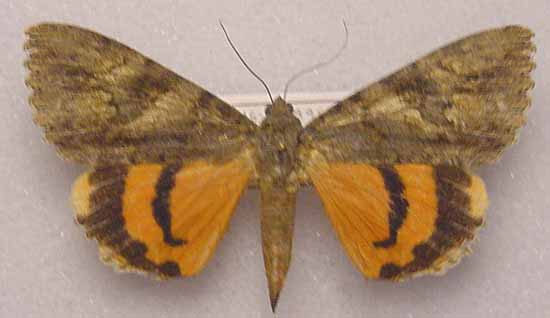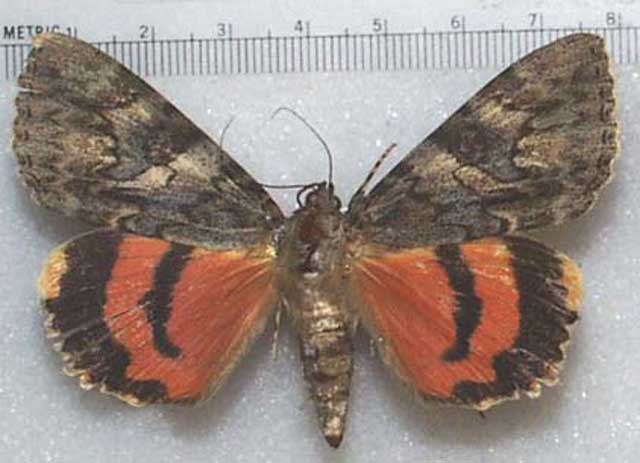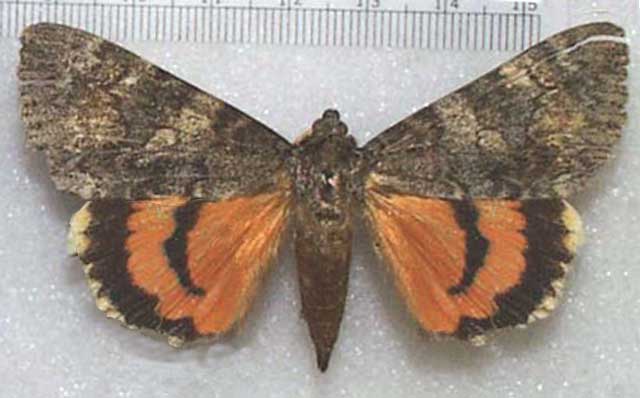Catocala babayaga = jessica
kah-TOCK-uh-lahmmbah-bah-YAY-ga
Strecker, 1884

Catocala babayaga = jessica Garden Cyn, Huachuca Mts, Cochise County,
AZ.
Oct 16, 1998. L. Muller, collector, given to Kelly Richers
by Ron Leuschner.
This site has been created by
Bill Oehlke at oehlkew@islandtelecom.com
Comments, suggestions and/or additional information are welcomed by Bill.
| TAXONOMY:
Superfamily: Noctuoidea
Family: Noctuidae
Group: Noctuinina
Subfamily: Catocalinae
Genus: Catocala, Schrank, 1802
| |
MIDI MUSIC
"Moon River"
copyright C. Odenkirk
MIDI CITYON.OFF
<bgsound src="moon.mid" LOOP=FOREVER>
|
DISTRIBUTION:
Catocala babayaga = jessica
(wingspan: 75mm) flies from Arizona to Colorado to Illinois.
Moths previously described as Catocala babayaga are now classified as
Catocala jessica.
The forewing is greyish-brown. Oblique am line has pointed lobes. The pm line has two upper teeth that are not greatly produced, with the upper
tooth noticebly wider and longer. Third tooth is greatly reduced, borders a brownish subterminal area, and is
followed by a larger tooth on the open subreniform line.
The double reniform spot is in a darker region of the wing. Just below it, the large, much lighter and open subreniform spot
breaks the pm line. There is a light area toward the costa on the body side, above the subreniform spot.
The hindwing is salmony-orange with a thin, relatively even black median band. The band angles slightly toward the inner margin
but is truncated well before same. Fringes are lighter orange as compared to basal and median areas and are heavily checked with black.
The inner margin has a fine grey fringe but the basal and median areas are pretty much devoid of any black or darker scaling.

Catocala babayaga = jessica, Arizona, courtesy of Bruce Walsh.

Catocala babayaga = jessica, Arizona, courtesy of Bruce Walsh.
FLIGHT TIMES AND PREFERRED FOOD PLANTS:
Catocala babayaga = jessica are usually on the wing in the fall: October.
The Catocala babayaga caterpillar shows a preference for willows and poplars.
ECLOSION:
Adults eclose from pupae at soil surface.
SCENTING AND MATING:
Catocala babayaga = jessica females
emit an airbourne pheromone and males use their antennae to track the
scent plume.
EGGS, CATERPILLARS, COCOONS AND PUPAE:
Eggs are deposited on
tree bark in the fall and hatch the following spring.
Larval Food Plants
Listed below are primary food plant(s) and alternate food plants.
It is hoped that this alphabetical listing followed by the common
name of the foodplant will prove useful. The list is not exhaustive,
although some species seem very host specific.
Experimenting with closely related foodplants is worthwhile.
Populus......
Salix
|
Poplar
Willow
|
Return to Main Index
This page is brought to you by
Bill Oehlke and the
WLSS. Pages are on space rented from Bizland. If you would like
to become a "Patron of the Sphingidae/Catocala Sites",
contact Bill.
Please send sightings/images to Bill. I will do my best to respond to
requests for identification help.


